Protecting Your Dog in a Disaster
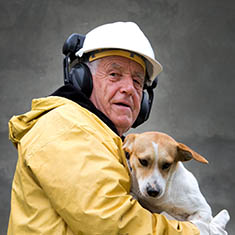
Fire Prevention
Before you bring a puppy into your home, part of the puppy-proofing process involves safe-guarding your electrical cords. If it’s not possible or practical to put them out of the puppy’s reach, put baby gates across the room door to keep the puppy away from the area entirely. And if you’re bringing home a grown dog with whom you’re not totally familiar, take similar precautions until you learn their individual foibles.
Don’t use extension cords under conditions for which they aren’t rated. If the tag says indoor use only, this is not the cord to use for your Christmas yard decorations. And no extension cord is made to be run under carpeting. When people walk over the rug and step on the cord, it wears down the insulation. When the insulation cracks all the way through, the cord can spark and ignite the rug.
Space heaters may not be the best choice in a home filled with dogs, or even one with just a single dog. Wagging tails, a rough game of tug or simply a quick run past to check on the squirrel outside the window can tip the heater, causing a fire. If you do use a space heater, make sure it has an auto-off feature to shut down operations when the unit is tipped. All combustibles must be kept at least three feet away from any space heater in use.
Combustibles must also be kept at least ten feet away from any place where sparks might fly, such as near the fireplace or your favorite smoking chair. It might be convenient to keep your newspapers in a container near your chair until you get enough to take to the recycling center, but they could be the fuel that ignites when you drop an ember. Don’t forget about pilot lights. Your basement might be a great place to store things, but make sure you don’t store anything near a gas water heater or furnace.
And speaking of pilot lights, any appliance with one produces carbon monoxide which can be just as deadly as a fire. This odorless, colorless gas is produced by any motor that runs on fossil fuels. This also includes wood stoves and kerosene heaters. If you have any of these appliances, you need a carbon monoxide detector in the area with the appliance.
Keep the area around your appliances clear to make sure there is plenty of air flow in all directions which will prevent the build-up of carbon monoxide. This is especially important if you live in a newer, well-insulated home which doesn’t allow drafty air to flow around.
Periodically inspect your home to make sure you are maintaining proper clearance around your fossil fuel appliances, and use this time to also check your housekeeping practices. Do you leave things on the steps to take upstairs or downstairs “later”? These tripping hazards can mean the difference between getting out alive and perishing in a heap at the bottom of the steps.
How’s your stove look? It’s tempting to stack things on top, particularly if you don’t cook a lot, but papers and hot pads can catch on fire if someone turns on the wrong burner accidentally. If your dogs are allowed in the kitchen when you do cook, make sure you keep the pot handles turned to the back to prevent them from being knocked off.
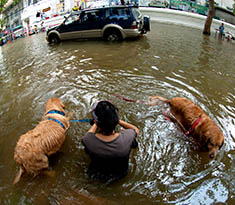
Evacuation Plans
Although your dogs will certainly not understand your schematically drawn evacuation plan, they will benefit from the planning process if the unthinkable happens. A well-thought out evacuation plan includes primary and secondary routes of escape from each room, as well as a designated meeting spot away from the building.
Part of your evacuation planning should include how the animals will be saved. Will you crate them before taking them outside or grab a leash on the way out the door? What if you cannot get to a door and have to go out of a window? Who is responsible for getting each of your dogs to safety? What if the dog gets spooked and refuses to come with you? Plan on your dog being very scared and forgetting everything he or she ever knew about obedience.
You might want to ask a neighbor if you can use their fenced in yard in the event of a fire, or you might plan to put the dogs into your car if the car is parked away from the house.
Practice your evacuation plan frequently. Although you won’t be able to recreate the terror associated with the smoke and flames, you will get your dogs and your other family members used to the process.
Install smoke detectors on every floor of your home. Test the batteries monthly and replace them twice a year when you change your clocks. Purchase a home fire extinguisher and make sure you know how to use it. However, if you cannot put out the fire within a few seconds, it’s time to give up and leave. Fire spreads very quickly, and the incapacitating fumes spread even faster.
If you are building a new home, consider including a residential sprinkler system. The system will cost less than your flooring to install in new construction and could save the lives of your loved ones. A good sprinkler system will detect smoke, send an alarm to the fire department, and put out any fire that can be extinguished with plain water.
Tornadoes
In most cases, the weather service is able to give advance warning of storms, which will give you time to get your family and your dogs to safety. Preparation is the key to surviving. The best place to weather a tornado is in the northwest corner of your basement, so set up a shelter area in advance of the need.
You might consider installing a tether of some kind to keep your dog with you in the corner. Again, the dog will be terrified, so you may need something more than your words to keep him or her still. Put some blankets and old pillows in the corner so you can cover up against falling debris during the worst of the storm.
Make sure to stock your shelter area with water, non-perishable food for your family and your animals, a battery-powered radio, and a flashlight. Don’t forget bowls and leashes for the dogs, and a can opener if needed for the food you stock. If you have a battery-operated cell phone charger, you might want to put that with your emergency shelter kit, and don’t forget to grab your cell phone on the way downstairs. It is highly probable that landline phones will not work because the storm will take down the wires. After a major storm it can take more than a week to get power and telephone service restored to everyone.
The American Red Cross encourages you to be able to care for yourself for at least three days until help can arrive. Keep in mind that if you will have to stay in a shelter, pets are usually not allowed unless they are service animals. Make a plan for where you will board your dog if you have to evacuate your home, and have a “go bag” packed with food, leashes, water, medications, and any other necessities for your dog.
After the storm
When the all-clear is given, keep your dogs locked up until you have investigated the area outside your home. Is your fence intact? Is there debris in the yard that could cut their paws or hurt them in other ways? Is there standing water that might be brackish or mixed with harmful chemical run-off? Are there downed wires in the area? Always assume a downed wire is “hot” until proven otherwise.
Last but not least, remember that after a disaster strikes your dog is likely to be as traumatized as you are. Consult with your vet to find the best way to help your dog through this stressful time.
Doggies Den: Latest Articles
 Homemade Thanksgiving Treats for Your Dog
Homemade Thanksgiving Treats for Your Dog
NUTRITION We all want to include our dogs in our holiday celebrations, but hopefully, you're aware that sharing table scraps with your dog isn't always the best idea.
 Keeping Your Dog Safe during the Summer Months
Keeping Your Dog Safe during the Summer Months
HEALTH Summer is coming on fast, so it’s time to plan how you will keep your dog safe and healthy through the lazy, carefree, warm days.
 Vaccination Time Again-Keeping Your Puppy Healthy
Vaccination Time Again-Keeping Your Puppy Healthy
DOG HEALTH So you have your new puppy picked out. There are quite a few shots, treatments and examinations that will keep the newest member of your family healthy.
 Canine Thanksgiving Feast
Canine Thanksgiving Feast
NUTRITION With the wide variety of food at Thanksgiving dinner, chances are you'll want to give your dog something special, too. If you're contemplating what to feed your dog for the holiday, here is a guide to a great Canine Thanksgiving Feast.
 Dog Walking Tips Every Owner Should Know
Dog Walking Tips Every Owner Should Know
DOG FUN Walking your dog is not only crucial to keeping him healthy and happy, it strengthens the bond between your canine friend and his caregiver. There are a lot of obstacles out there. Don’t forget these simple tips to keep your walk fun and safe in the outside world.
 The Benefits of Physiotherapy for your Dog
The Benefits of Physiotherapy for your Dog
HEALTH The same techniques that physiotherapists use to treat a variety of injuries and conditions in humans have been adapted to suit animals with great success. Family pets, show dogs, and working dogs can all benefit greatly from physiotherapy. Dogs whose activities involve a lot of agility are especially susceptible to the types of problems that physiotherapy can address.
 The Decision- Adding a Dog to Your Family
The Decision- Adding a Dog to Your Family
FIRST TIME OWNERSBringing a dog into your family is a decision where many people don’t realize it’s magnitude until after they have the dog. There are a number of things that you need to research before you decide to purchase a dog, and it starts right in your own home.
 Bringing Your Dog Into Your New Baby's Life
Bringing Your Dog Into Your New Baby's Life
HEALTH Many believe that a dog and a new baby cannot happily coexist, so therefore the dog has to go. This is not necessarily the case.  A new baby does not mean you have to abandon your dog.

Doggies Den:
Most Popular Articles

Dog Pregnancy Symptoms
HEALTHIf you suspect your dog might be pregnant, check out part one in this series on pregnant dogs, where we cover pregnant dog symptoms.
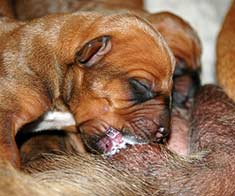
Dog Birth
HEALTHIn the third article of our dog pregnancy series, we look at the wonderful, but messy, process of bringing newborn puppies into the world.

Indoor Dog Potties
DOG PRODUCTSIt's been a long day at work. You were so busy, you didn't even take time to eat a sandwich, let alone run home to let your dog out. You're on your way home, knowing the poor dog is crossing his or her legs by now, when your car breaks down, delaying you even further. Can't somebody make this easier?
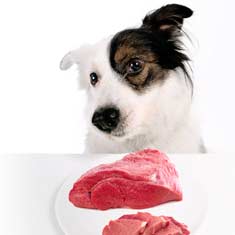
Your Dog’s Digestive System
PHYSIOLOGYEver wonder why your dog eats so fast? Or why he eats gross things? Or why he gets sick to his stomach? Or why his waste stinks so bad? Some of these things are normal, some are not.

Canine Respiratory System
BREATHINGThe basic function of your dog's respiratory system is to bring oxygen in to and remove carbon dioxide from the body. Knowing the symptoms of respiratory diseases can help you help your stay healthy.
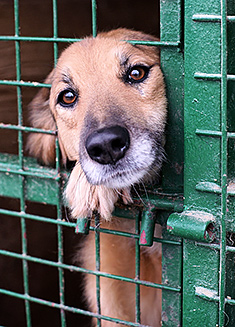
Shelter Dog Adoption Tips for Success
ADOPTION Are you intimidated by the prospect of "rescuing" a dog from a shelter? One reason that you may be wary of adopting a dog from a shelter is not knowing how to choose. Adopting a dog from a shelter can be a rewarding process, if you're prepared to do a reasonable amount of research.

Canine Urinary Tract Infections
SYMPTOMS AND TREATMENTDoes your dog seem to be having trouble relieving his or her bladder? Learn how to recognize the signs of urinary tract infections and how to treat them before they spread.

What to do for Dog Diarrhea
SYMPTOMS AND REMEDIESIf you have dogs in your house for any length of time, you have likely experienced at least one bout of dog diarrhea. Beyond the pain in the tuckus involved in cleaning up the mess, you should know what causes diarrhea, and when it's important to see the vet.
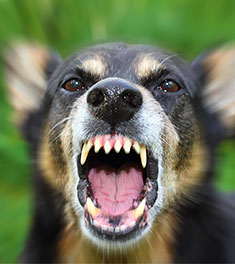
What to do for a Dog Bite
DOG BEHAVIOR Getting bitten by a dog can be scary, and you may be tempted to run around in circles for a while, trying to figure out what to do. Here's our guide to help you manage the situation.

Top Ten Tips for Living with a Senior Dog
DOG HEALTH Bringing home a new puppy is so exciting, but it doesn’t take all that long for your exuberant puppy to grow into a senior dog who may have special needs. Here are the doggies.com top ten tips for taking care of your companion who has been with you through so much.
